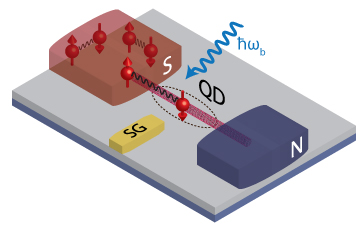Electrons Always Find a (Quantum) Way

Transport process of electrons from a superconductor (S) through a quantum dot (QD) into a metal with normal conductivity (N). Illustration: University of Basel, Department of Physics
Transport properties such as electrical conductivity play an important role in technical applications of new materials and electronic components. Completely new phenomena occur, for example, when you combine a superconductor and nanometer-sized structures, known as quantum dots, in a component.
Researchers at the University of Basel working under Professor Christian Schönenberger have now constructed such a quantum dot between a superconductor and a metal with normal conductivity to study electron transport between the two components.
It should in fact be impossible to transport electrons from the superconductor through a quantum dot at low energies. Firstly, electrons never occur on an individual basis in a superconductor but rather always in two's or in so-called Cooper pairs, which can only be separated by relatively large amounts of energy. Secondly, the quantum dot is so small that only one particle is transported at a time due to the repulsive force between electrons.
In the past, however, scientists have repeatedly observed that a current nonetheless runs between the superconductor and the metal – in other words, electron transport does occur through the quantum dot.
First evidence of the transport mechanism through a quantum dot
On the basis of quantum mechanics, theories were developed in the nineties which indicated that the transport of Cooper pairs through a quantum dot is entirely possible under certain conditions. The prerequisite is that the second electron follows the first very quickly, namely within the time roughly stipulated by Heisenberg's uncertainty principle.
The scientists at the University of Basel have now been able to accurately measure this phenomenon. In their experiments the scientists found the exact same discrete resonances that had been calculated theoretically. In addition, the team including doctoral student Jörg Gramich and his supervisor Dr. Andreas Baumgartner was able to provide evidence that the process also works when energy is emitted into the environment or absorbed from it.
“Our results contribute to a better understanding of the transport properties of superconducting electronic nanostructures, which are of great interest for quantum technology applications”, says Dr. Andreas Baumgartner.
Original source
J. Gramich, A. Baumgartner, and C. Schönenberger
Resonant and inelastic Andreev tunneling observed on a carbon nanotube quantum dot
Physical Review Letters 115, doi: 10.1103/PhysRevLett.115.216801
Further information
Dr. Andreas Baumgartner, University of Basel, Department of Physics, tel. +41 61 267 39 06, email: andreas.baumgartner@unibas.ch
Media Contact
More Information:
http://www.unibas.chAll latest news from the category: Physics and Astronomy
This area deals with the fundamental laws and building blocks of nature and how they interact, the properties and the behavior of matter, and research into space and time and their structures.
innovations-report provides in-depth reports and articles on subjects such as astrophysics, laser technologies, nuclear, quantum, particle and solid-state physics, nanotechnologies, planetary research and findings (Mars, Venus) and developments related to the Hubble Telescope.
Newest articles

“Nanostitches” enable lighter and tougher composite materials
In research that may lead to next-generation airplanes and spacecraft, MIT engineers used carbon nanotubes to prevent cracking in multilayered composites. To save on fuel and reduce aircraft emissions, engineers…

Trash to treasure
Researchers turn metal waste into catalyst for hydrogen. Scientists have found a way to transform metal waste into a highly efficient catalyst to make hydrogen from water, a discovery that…

Real-time detection of infectious disease viruses
… by searching for molecular fingerprinting. A research team consisting of Professor Kyoung-Duck Park and Taeyoung Moon and Huitae Joo, PhD candidates, from the Department of Physics at Pohang University…





















